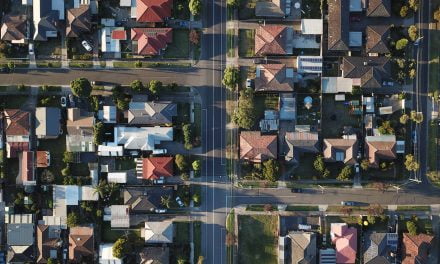Few residents need a reminder that the Golden State is in the clutches of a devastating housing crisis. Homelessness and housing costs are high while new construction and sales volume trudges along. Despite this, a sweeping bill aimed at easing California’s housing woes by allowing higher-density development near train stations was just stopped in its tracks.
Senate Bill 50 (SB 50), also known as the More HOMES Act, promoted higher-density housing development near transit- and jobs-rich areas. It called for the “upzoning” of areas near major transit stops to restrict enforcement of many local zoning ordinances, like height limits and parking requirements. This would have allowed four-to-five-story apartment buildings and up to fourplexes near mass transit stops and job centers.
To picture the scale of this legislation, consider that the City of Los Angeles estimated 43% of its developable land would have been eligible for higher-density development under SB 50.
Do the locomotion
At first, SB 50 seemed unstoppable. San Francisco Senator Scott Wiener introduced the bill in December 2018. It easily passed the California Senate Housing Committee. The bill’s aggressive protections for existing renters and promise to rapidly expand housing around transportation hubs also garnered the support of Yes-in-my-backyard (YIMBY) activists, among other influential groups.
Recent polling also showed the bill was quite popular among California voters. In one poll, 66% of California voters surveyed supported SB 50 while 18% opposed it, according to polling by Lake Research Partners.
Another poll by Change Research yielded similar results, with 61% of voters surveyed supporting the bill and 22% opposing. Unsurprisingly, both polls revealed a wide partisan rift, with Democrats favoring the bill in greater numbers than Republicans.
Nevertheless, SB 50 cleared a major hurdle in the California Senate Governance and Finance Committee in April 2019. With this win, the bill was gaining steam and on track to realizing the state’s most ambitious legislative step in easing the housing crisis.
Derailed
And then it was shelved. In May 2019, SB 50 was converted into a two-year bill, blocking it from leaving the California Senate Appropriations Committee. This means the bill won’t be eligible for debate or a vote on the California Senate floor until 2020.
SB 50 had the support of many municipal leaders, chambers of commerce, environmental groups (the bill’s focus on mass transit would have helped reduce carbon emissions from California’s notorious traffic jams) and business groups. It won endorsements from the New York Times and Los Angeles Times. It cleared the California Senate Housing and Governance and Finance Committees. So how did a bill with so much momentum go off the rails?
Critics point to the bill’s regulatory overreach. It’s no surprise that city officials would balk at the idea of surrendering zoning control to the state. (Not-in-my-backyard) NIMBY advocates protested that SB 50 effectively eliminated single-family residence (SFR) zoning in many areas. It would have changed the character of cities without local input, they argued.
They also contested that new housing resulting from SB 50 would have mostly benefited high earners instead of the low- and moderate-income households for whom it was intended. This is because the high cost of construction would have forced newly erected high-density housing to debut with an equally inflated price tag to turn a profit. A valid concern, considering overwhelming land, building, permitting and labor costs have all but gridlocked new construction in California.
Unstoppable force, meet immovable object
But as the California Senate Appropriations Committee Chair, Senator Anthony Portantino was ultimately responsible for stopping the runaway bill. Senator Portantino is a former mayor of La Cañada Flintridge, a predominantly SFR suburb. Portantino’s district includes other bedroom communities that felt similarly threatened by the mid-rise construction SB 50 would have brought to their cities.
Portantino claimed SB 50 wasn’t targeted enough. So in February 2019, the senator introduced his own solution: Senate Bill 509 (SB 509), a laughable license plate program that sought to raise awareness for the California housing crisis. Under Portantino’s bill, the proceeds from the license plate sales would have been later appropriated by the California legislature for housing-related programs.
Californians forced to live through the crisis are well aware of it and a promotional license plate would not have generated nearly enough revenue to address the issue. California needs a substantial compromise that balances affordable housing expansion with protections for existing residents.
A platform for change
The California Budget and Policy Center claims that roughly half of California households are cost burdened, meaning they spend more than 30% of their income on housing costs. This is the tipping point at which a household may have difficulty affording essentials like food, clothing and medical care, according to the U.S. Department of Housing and Urban Development (HUD).
An Apartment List study found that renters with a median household income seeking a two-bedroom rental are cost burdened in 25 major U.S. markets. It’s no surprise for anyone familiar with California’s high cost of housing that 12 out of these 25 U.S. cost-burdened metros are located in the Golden State.
Related article:
A crisis of this magnitude calls for a seismic shift in policy, but SB 50’s ambition to move mountains did not come without polarization. For now, Californians will have to wait. SB 50 has not been decommissioned, just delayed.














